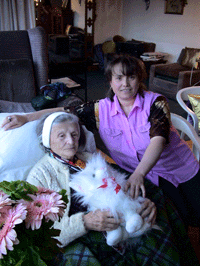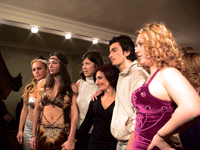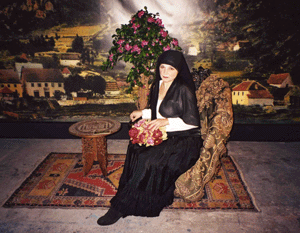|
|

Gülsün Karamustafa, Unawarded Performances, 2005

Gülsün Karamustafa, Memory of a Square, 2005

Gülsün Karamustafa, Tailor Made, 2005
|
englisch version

Gülsün Karamustafa, The Settler, 2003
Die Ausstellung Memory of a Square in der Kunsthalle Fridericianum präsentiert die Videoarbeiten der Künstlerin Gülsün Karamustafa der Jahre 2000 - 2005. Neben ihren Objektarbeiten und Installationen wendet sich Karamustafa in den letzten Jahren verstärkt dem Medium Film zu, vor allem aufgrund dessen Fähigkeit, Geschichten
zu erzählen, poetische Momente festzuhalten und historische und soziale Zusammenhänge anschaulich zu machen. Sie wählt dafür oft die Form des
Interviews, gibt Menschen – deren Schicksale und Geschichten meistens im Verborgenen bleiben – ein Gesicht und eine Stimme.
Auch wenn die künstlerischen Medien wechseln, Themen wie Migration, die Suche nach der eigenen Identität zwischen West und Ost, die Rolle der Frau in der türkischen Gesellschaft oder die politische Entwicklung des Landes bestimmen seit vielen Jahren ihr künstlerisches Schaffen. In den meisten Fällen gibt die Stadt Istanbul – die Stadt in der sie lebt und arbeitet – als Mikrokosmos die Themen von globaler Bedeutung vor, denen die Künstlerin in ihren Arbeiten nachgeht.
Stellvertretend für diese Verbindung steht ihre Videoarbeit Memory of a Square aus dem Jahr 2005. Darin verbindet sie die spannungsreiche Geschichte des zentralen Taksim Platzes im Herzen der Stadt mit Szenen aus dem häuslichen Alltagsleben einer Familie. Die als Doppelprojektion konzipierte Arbeit zeigt zum einen dokumentarisches Filmmaterial aus der abwechslungsreichen Geschichte des Platzes von den 1930er bis zu den 1980er Jahren. Gleichzeitig scheint es, als stünde diese Geschichte stellvertretend für die politische Entwicklung des Landes. Demonstrationen, gewalttätige Auseinandersetzungen, Festlichkeiten und das Enthüllen von Denkmälern spiegeln immer auch die aktuelle gesellschaftliche und politische Situation. Die zweite Projektion zeigt in elf Episoden verschiedene Alltagsszenen einer Familie, die aus drei Generationen besteht. Das Ambiente der Wohnung ist bürgerlich. Es wird nicht gesprochen, lediglich aus Mimik und Gestik lässt sich der emotionale Zustand der Protagonisten ablesen. Über die Musik und einzelne Hinweise wird für die Betrachter eine Verbindung deutlich, ergibt sich ein Zusammenhang zwischen den beiden Projektionen. Karamustafa macht deutlich, wie sehr die politische Sphäre mit der privaten verbunden ist, wie stark es das Leben des Einzelnen beeinflussen kann.
Gülsün Karamustafa (*1946) lebt und arbeitet in Istanbul
Einzelausstellungen (Auswahl)
Black and White Visions, Prometeo Gallery, Mailand, 2006; Gülsün Karamustafa, kunstraum lakeside, Klagenfurt, 2006; Men Crying, Musée d´art Moderne de la Ville de Paris, Immanence Gallery, Paris, 2005; Hold on – Keep Quiet, Liesbeth Lips Gallery, Rotterdam, 2002; Mystic Transport, Trellis of my Mind, Musee d´art et d´histoire, Genf, 1999; Promised Paintings, Black and White Gallery, Ankara, 1998.
Gruppenausstellungen (Auswahl)
IstanbulEindhoven, VanAbbe Museum, Eindhoven, 2005; Projekt Migration, Kölnischer Kunstverein, Köln, 2005; Centre of Gravity, Istanbul Modern, Istanbul, 2005; Love it or Leave it, 5. Cetinje Biennale, Cetinje (Montenegro), 2004; Call me ISTANBUL ist mein Name, ZKM, Karlsruhe, 2004; La Biennale de Venezia, 2003; Echolot oder neun Fragen an die Peripherie, Kunsthalle Fridericianum, Kassel, 1999.
Videoarbeiten in der Ausstellung:
Personal Time Quartet (2000), Men Crying (2001), Staircase (2001), Making of the Wall (2003), The Settler (2003), Memory of a Square (2005), Tailor Made (2005), Unawarded Performances (2005).
Begleitend zur Ausstellung erscheint ein Katalog mit einem Essay von Barbara Hein-rich, 68 Seiten, 80 Abbildungen (davon 30 Farbe), Preis: 8 Euro, ISBN 3-927015-48-2
The exhibition Memory of a Square at the Kunsthalle Fridericianum presents video works by the artist Gülsün Karamustafa from the period 2000 to 2005. In addition to her object works and installations, Karamustafa has in recent years turned her attention more and more to the medium of film, primarily because of its ability to tell stories, to capture poetic moments, and to illustrate historical and social contexts. She often chooses the interview form, giving people – whose fates and stories mainly remain hidden – a face and a voice. Even when the artistic media change, topics like migration, the search for one’s own identity between West and East, the role of the woman in Turkish society, or the political development of the country have marked her art for many years. In most cases, the city of Istanbul – where she lives and works – is the microcosm that provides the themes of global significance which the artist addresses in her works.
A typical example of this approach is her 2005 video work Memory of a Square. It links the compelling history of Taksim Square in the heart of the city with scenes from the everyday home life of a family. The work, in the form of a double projection, shows documentary film material on the rich and varied history of the square from the 1930s to the 1980s. At the same time, this history seems to stand for the political development of the country. Demonstrations, violent clashes, festivities, and the unveiling of monuments repeatedly reflect the prevailing societal and political situation. The second projection in eleven episodes shows various everyday scenes in the life of a family consisting of three generations. The home ambience is middle class. There is no speech, only facial expressions and gestures reveal the emotional state of the protagonists. Music and isolated indications establish a link, a connection between the two projections for the viewer. Karamustafa shows how closely the political sphere is coupled with the private sphere, how strongly it can influence the life of the individual.
Gülsün Karamustafa (*1946) lives and works in Istanbul
Individual exhibitions (selection)
Black and White Visions, Prometeo Gallery, Milan, 2006; Gülsün Karamustafa, kunstraum lakeside, Klagenfurt, 2006; Men Crying, Musée d´art Moderne de la Ville de Paris, Immanence Gallery, Paris, 2005; Hold on – Keep Quiet, Liesbeth Lips Gallery, Rotterdam, 2002; Mystic Transport, Trellis of my Mind, Musee d´art et d´histoire, Geneva, 1999; Promised Paintings, Black and White Gallery, Ankara, 1998.
Group exhibitions (selection)
IstanbulEindhoven, VanAbbe Museum, Eindhoven, 2005; Projekt Migration, Kölnischer Kunstverein, Cologne, 2005; Centre of Gravity, Istanbul Modern, Istanbul, 2005; Love it or Leave it, 5. Cetinje Biennale, Cetinje (Montenegro), 2004; Call me ISTANBUL ist mein Name, ZKM, Karlsruhe, 2004; La Biennale de Venezia, 2003; Echolot oder neun Fragen an die Peripherie, Kunsthalle Fridericianum, Kassel, 1999.
|